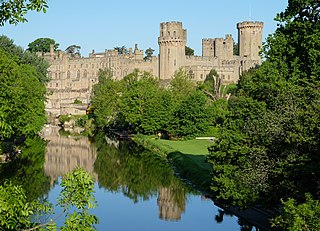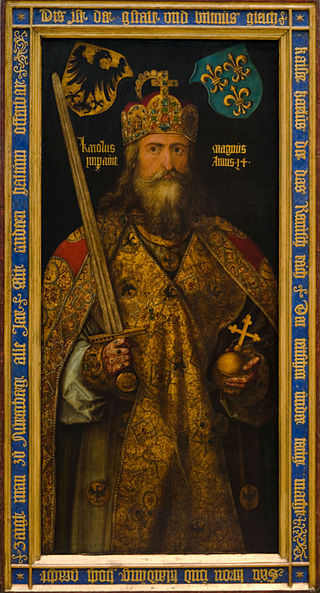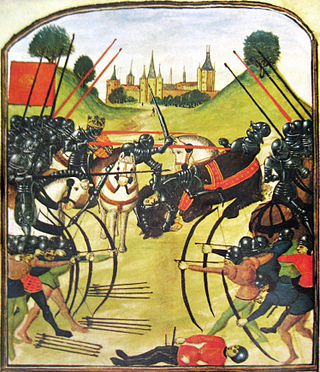
A rapier or espada ropera is a type of sword originally used in Spain The name designates a sword with a straight, slender and sharply pointed two-edged long blade wielded in one hand. It was widely popular in Western Europe throughout the 16th and 17th centuries as a symbol of nobility or gentleman status.
The spatha was a type of straight and long sword, measuring between 0.5 and 1 metre, with a handle length of between 18 and 20 centimetres, in use in the territory of the Roman Empire during the 1st to 6th centuries AD. Later swords, from the 7th to 10th centuries, like the Viking swords, are recognizable derivatives and sometimes subsumed under the term spatha.

Warwick Castle is a medieval castle developed from a wooden fort, originally built by William the Conqueror during 1068. Warwick is the county town of Warwickshire, England, situated on a meander of the River Avon. The original wooden motte-and-bailey castle was rebuilt in stone during the 12th century. During the Hundred Years War, the facade opposite the town was refortified, resulting in one of the most recognisable examples of 14th-century military architecture. It was used as a stronghold until the early 17th century, when it was granted to Sir Fulke Greville by James I in 1604. Greville converted it to a country house, and it was owned by the Greville family until 1978, when it was bought by the Tussauds Group.

Warwick is a market town, civil parish and the county town of Warwickshire in the Warwick District in England, adjacent to the River Avon. It is 9 miles (14 km) south of Coventry, and 19 miles (31 km) south-east of Birmingham. It is adjoined with Leamington Spa and Whitnash.

Earl of Warwick is one of the most prestigious titles in the peerages of the United Kingdom. The title has been created four times in English history, and the name refers to Warwick Castle and the town of Warwick.

Guy de Beauchamp, 10th Earl of Warwick was an English magnate, and one of the principal opponents of King Edward II and his favourite, Piers Gaveston. Guy was the son of William de Beauchamp, the first Beauchamp earl of Warwick, and succeeded his father in 1298. He distinguished himself at the Battle of Falkirk and subsequently, as a capable servant of the crown under King Edward I. After the succession of Edward II in 1307, however, he soon fell out with the new king and the king's favourite, Piers Gaveston. Warwick was one of the main architects behind the Ordinances of 1311, that limited the powers of the king and banished Gaveston into exile.

Guy of Warwick, or Gui de Warewic, is a legendary English hero of Romance popular in England and France from the 13th to 17th centuries, but now largely forgotten. The story of Sir Guy is considered by scholars to be part of the Matter of England.

Leek Wootton is a village and former civil parish, now in the parish of Leek Wootton and Guy's Cliffe, in the Warwick district, in the county of Warwickshire, England, approximately 2 miles (3.2 km) south of Kenilworth and 2.5 miles (4.0 km) north of Warwick. It lies in the triangle created by Kenilworth, Warwick and Leamington Spa. In 1961 the parish had a population of 671.
Curtana, also known as the Sword of Mercy, is a ceremonial sword used at the coronation of British kings and queens. One of the Crown Jewels of the United Kingdom, its end is blunt and squared to symbolise mercy.

Joyeuse was, in medieval legend, the sword wielded by Charlemagne as his personal weapon. A sword identified as Joyeuse was used in French royal coronation ceremonies since the 13th century, and is now kept at the Louvre.

The Lord Leycester Hospital is one of the best preserved examples of medieval courtyard architecture in England and is a charity supporting ex-servicemen. It is located in Warwick, England, next to the West Gate, on High Street. It is a Grade I listed building. The hospital is a prominent feature of Warwick. For almost 900 years buildings have been erected and civic activity has taken place on the site, starting with the chapel built in 1126. The site was donated by the 12th Earl of Warwick in the 14th century to the United Guild of the Holy Trinity and St George. The Guild Hall, Great Hall and Master's House were constructed in the late 15th century. Over the centuries, the ancient buildings and 500 year old gardens have been admired by visitors such as Charles Dickens and Oscar Wilde, King George V and the Queen Mother and travellers from around the world.

The term Italian school of swordsmanship is used to describe the Italian style of fencing and edged-weapon combat from the time of the first extant Italian swordsmanship treatise (1409) to the days of classical fencing.

Warwick School is a public school in Warwick, England.

Waleran de Beaumont, 4th Earl of Warwick was the second son of Earl Roger of Warwick and Gundreda de Warenne, daughter of William de Warenne, 2nd Earl of Surrey and Elizabeth de Vermandois. He was known in his elder brother's time as 'Waleran of Warwick' marking the shift of surname in the family in his generation. The surnames 'Beaumont' and 'Newburgh' were used by the first two generations of the family, and are applied to the later generations by convention.

Guy's Cliffe is a hamlet and former civil parish on the River Avon and the Coventry Road between Warwick and Leek Wootton, in the parish of Leek Wootton and Guy's Cliffe, in the Warwick district, in Warwickshire, England, near Old Milverton. In 1961 the parish had a population of 2.

William de Beauchamp, 9th Earl of Warwick was the eldest of eight children of William de Beauchamp of Elmley and his wife Isabel de Mauduit. He was an English nobleman and soldier, described as a “vigorous and innovative military commander." He was active in the field against the Welsh for many years, and at the end of his life campaigned against the Scots.

The Wars of the Roses, known at the time and in following centuries as the Civil Wars, were a series of civil wars fought over control of the English throne from 1455 to 1487. The wars were fought between supporters of the House of Lancaster and House of York, two rival cadet branches of the royal House of Plantagenet. The conflict resulted in the end of Lancaster's male line in 1471, leaving the Tudor family to inherit their claim to the throne through the female line. Conflict was largely brought to an end upon the union of the two houses through marriage, creating the Tudor dynasty that would subsequently rule England.

The Sword of Monte Cristo is a 1951 American adventure film written and directed by Maurice Geraghty. The film stars George Montgomery, Rita Corday, Berry Kroeger, William Conrad, Rhys Williams and Steve Brodie. It is loosely based on the 1844 novel The Count of Monte Cristo by Alexandre Dumas. The film was released on March 3, 1951, by 20th Century Fox.

Colbrand was a legendary giant from English folklore, supposedly defeated by Guy of Warwick, a legendary English hero of Romance popular in England and France from the 13th to 17th centuries. The story of Sir Guy is considered by scholars to be part of the Matter of England. According to the story, Guy returned to England after some years of absence to deliver Winchester for Athelstan of England from the invading northern kings, Anelaph and Gonelaph, by slaying in single combat their champion, the Danish giant Colbrand.
















